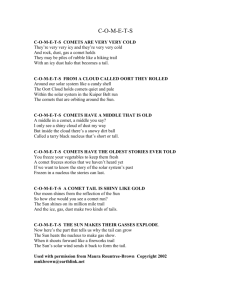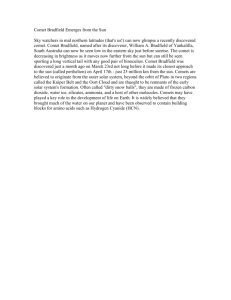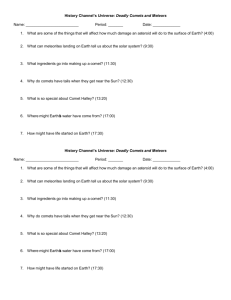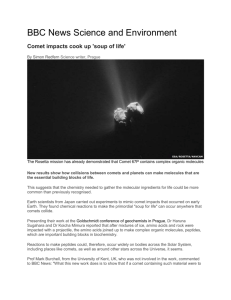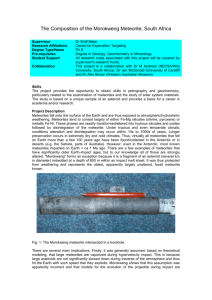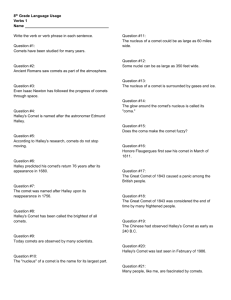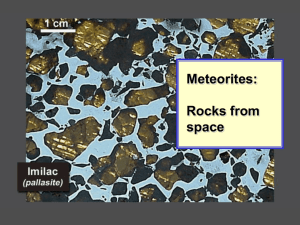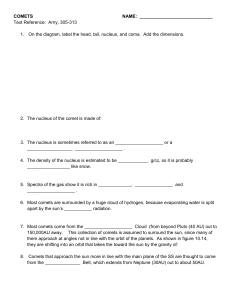Asteroid
advertisement
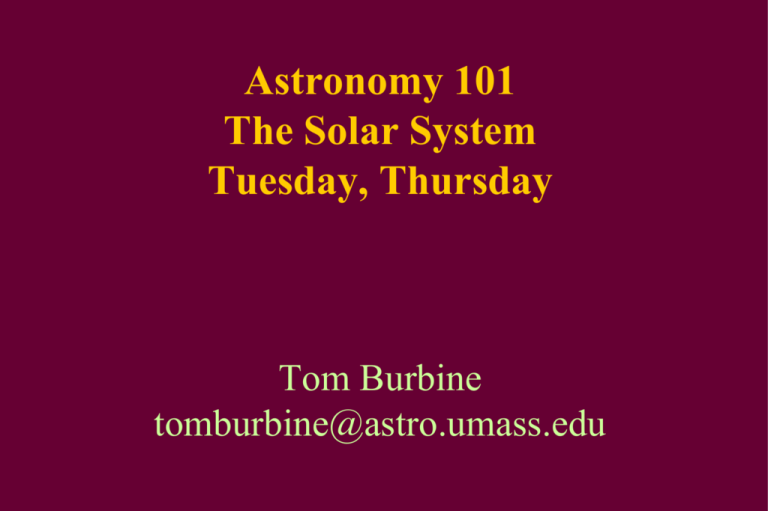
Astronomy 101 The Solar System Tuesday, Thursday Tom Burbine tomburbine@astro.umass.edu Course • Course Website: – http://blogs.umass.edu/astron101-tburbine/ • Textbook: – Pathways to Astronomy (2nd Edition) by Stephen Schneider and Thomas Arny. • You also will need a calculator. Exam #4 • Median score is 80 • Average score was 77.3 • Grades ranged from a 30 to 100s HW • Homework #21, #22, and #23 are due by May 4th at 1 pm Final Grades • • • • • Grades so far for people who have taken all 4 exams 4 exams plus average of HWs #1-20 Median Grade – 81.9 Average Grade – 80.5 Grades range from a 50.3 to a 98.3 Asteroids as Geologic Bodies • Asteroids are composed of different minerals • Asteroids tend to be covered by craters • Asteroids have a regolith (particulate surface) http://antwrp.gsfc.nasa.gov/apod/ap951020.html 25143 Itokawa (535 × 294 × 209 m) 433 Eros http://homepage.ntlworld.com/heather.hobden1/Itokawa.jpg http://www.astro.cornell.edu/~richardson/Seismic/ponds.gif 951 Gaspra (taken by Galileo spacecraft) • 20 x 12 x 11 km • Galileo spacecraft flew by this asteroid 243 Ida (taken by Galileo spacecraft) • 56 x 24 x 21 kilometers • Galileo spacecraft flew by this asteroid Ida has a satellite Dactyl NEAR-Shoemaker mission to 433 Eros • NEAR stands for Near-Earth Asteroid Rendezvous • Shoemaker is for Gene Shoemaker • Launch date: Feb. 17, 1996 • The first of four scheduled rendezvous burns on December 20, 1998 aborted due to a software problem • Rendezvous delayed for a year • Orbital insertion around Eros occurred on February 14, 2000 13 × 13 × 33 km 433 Eros • Surface of 433 Eros • Landing of NEAR-Shoemaker on Eros Hubble Image of 4 Vesta Dawn Spacecraft will visit 4 Vesta and 1 Ceres • Launched September 27, 2007 • Will orbit Vesta in 2011-2012 • Will orbit Ceres in 2015 http://en.wikipedia.org/wiki/Image:Dawn_Flight_Configuration_2.jpg The Hayabusa Mission Japanese mission to return a sample from an asteroid Hayabusa target Normalized Reflectance 1.6 25143 Itokawa (Binzel et al., 2001) 1.5 1.4 1.3 1.2 1.1 1 Greenwell Springs (LL4) 0.9 0.8 0.4 0.8 1.2 1.6 2 Wavelength (microns) 2.4 Mission Overview • Hayabusa means ‘falcon’ in Japanese • Mission Statement – “to bring back samples from and asteroid and investigate the mysteries of the Solar System” • Launched May 9, 2003 • Flew to 25143 Itokawa (formerly 1998 SF36), named for Hideo Itokawa who was the father of the Japanese space program Mission Goals • • • • Make contact with and land on Itokawa Gather samples of regolith on the surface Return samples to Earth for study Test new technologies for future missions – Ion engines – Autonomous navigation system - approaches the target far away without human guidance – Asteroid landing and sample collection system – Re-entry capsule system Instrumentation • • • • XRS – X-ray based spectrometer ONC – Optical Navigation Camera LIDAR – LIght Detection And Ranger Minerva - MIcro/Nano Experimental Robot Vehicle for Asteroid, ‘hopper lander’ • Re-entry capsule – capable of withstanding heat 30 times that of the Apollo ship and forces 25 times the acceleration of gravity • dimensions 540 meters by 270 meters by 210 meters Sample • Sample container will hopefully land in Australia this June Meteors Meteorite • A small extraterrestrial body that reaches the Earth's surface Why are meteorites important? Why are meteorites important? • They are primarily fragments of asteroids, which can hit us • They are records of the early solar system Moon Meteorites • Usually have ages of ~4.6 billion years • Asteroids and comets are thought to be the building blocks of the terrestrial planets Meteorites • Many early cultures recognized (or believed) certain stones as having fallen from the sky • Many early cultures had tools made from iron meteorites • But to the scientists of the Renaissance and later periods, stones falling from the heavens were considered superstition or heresy More evidence … • In 1492, a meteorite weighing almost 130 kilograms landed near the town of Ensisheim, Alsace, France, then in the hands of Germany Then .. • In 1794, Ernst Friedrich Chladni, considered the father of meteoritics, published a book in which he concluded that stone and iron masses did fall out of the sky • In 1803, thousands of meteorite fragments bombarded L'Aigle in Normandy, France, an event investigated by Jean-Baptiste Biot of the French Academy of Science. Thomas Jefferson • Meteorite landed in Weston, CT • It was brought to Yale where it was concluded it was from outer space • Thomas Jefferson, President of the United states, was told about it And responded • "Gentlemen, I would rather believe that two Yankee professors would lie than believe that stones fall from heaven." Meteorites • Named after a nearby geographic locality Meteorite • Esquel Pallasite • Found in Esquel, Argentina Meteorites • Almost all are thought to be fragments of asteroids • Where else can they come from? Meteorites • Almost all are thought to be fragments of asteroids • Where else can they come from? – – – – – – Moon - ~42 samples Mars - ~34 samples Comets? Venus? Mercury? Other solar systems? Peekskill Meteorite • http://aquarid.physics.uwo.ca/~pbrown/Videos/peekskill.htm Meteorites • Meteorites are composed of different minerals – – – – Silicates – contain silicon and oxygen Sulfides – contain sulfur Oxide – contains oxygen Iron-nickel metal Meteorites • Usually named after the town (or nearest town) where they fell or were located Falls and Finds • Falls – see them fall • Finds – find them Fall Statistics (greater than 1%) • • • • • • • • • • Meteorite type L chondrites H chondrites LL chondrites Irons Eucrites Howardites CM Diogenites Aubrites Fall Percentages 38.0% 34.1% 7.9% 4.2% 2.7% 2.1% 1.7% 1.2% 1.0% Where is the best place to find meteorites on Earth? Where is the best place to find meteorites on Earth? • Antarctica • Deserts – Sahara Antarctic Meteorites • Designation for which ice field they were found • ALH Allan Hills EET Elephant Moraine LEW Lewis Cliff • Then year and then number (which gives order of discovery) • For example, ALH 84001 was first meteorite discovered in 1984-1985 field season How do you know a rock is a meteorite? • • • • • • • Some possible indicators Presence of Iron-Nickel (FeNi) Metal Density Magnetism Presence of Chondrules Fusion Crust Regmaglypts – Ablation of meteorite while passing through atmosphere Meteor-wrongs • For example, magnetite (Fe3O4) is magnetic, but has grey streak • The best test is finding Ni in the metallic iron • • • • • • • • • • • • • • • • NWA 736 (H3.7) Hassayampa (H4) Pultusk (H5) NWA 869 (L5) Holbrook (L6) Long Island (L6) NWA 2040 (LL3.5) NWA 1584 (LL5) NWA 852 (CR2) NWA 2086 (CV3) NWA 800 (R4) NWA 1929 (Howardite) NWA 3140 (Ureilite) Canyon Diablo (iron) Nantan (Iron) Sikhote-Alin (Iron) NWA stands for North West Africa • • • • • • • • • • • • • • Acapulcoites Angrites Ataxites Aubrites Brachinites CB CH CI CK CM CO CR CV Diogenites • • • • • • • • • • • • • • • EH EL Eucrites H Hexahedrites Howardites L LL Lodranites Mesosiderites Octahedrites Pallasites R Ureilites Winonaites Basic types • Stony – primarily silicates (but can have some FeNi) • Stony-Iron – ~50-50 mixture of silicates and FeNi • Iron –almost all FeNi (Silicates are minerals containing Silicon, and usually Oxygen.) Types of Stony Meteorites • Chondrites – Heated but have not melted – Tend to contain chondrules –frozen molten droplets – Aggregates of high- and low-temperature components • Achondrites – Heating to the point of melting – Tend to differentiate • Where material segregates due to density • Chondritic body • Differentiated body Ordinary Chondrites • Most common type of meteorite to fall to Earth • Ordinary Chondrites – primarily olivine, pyroxene, and metal – H – high-iron – 34% of falls – L – low-iron – 38% of falls – LL – very low-iron – 8% of falls Carbonaceous Chondrites • Meteorites that contains high levels of water and organic compounds • Water is in hydrated silicates • Have not undergone significant heating (>200°C) since they formed Carbonaceous Chondrites • • • • • • • • CI1 CM2 CR2 CH2 CB3 CO3 CV3 CK3 I is for Ivuna M is for Mighei R is for Renazzo H is for High-Metal B is for Bencubbin O is for Ornans V is for Vigarano K is for Karoonda – Could be CK4 or CK5 CI1 chondrite • Ivuna – up to 20 wt.% water CI chondrites have elemental compositions similar to the Sun CM2 chondrite • Murchison CV3 chondrite • Allende • Fell February 8, 1969 • Over 2,000 kilograms of material was recovered CV3 chondrite • Contain chondrules • And Calcium Aluminum Inclusions (CAIs) – They consist of high-temperature minerals, including silicates and oxides containing calcium, aluminum, and titanium. – Some CAIs were dated at 4.57 billion years, making them the oldest known objects in the solar system Difference • Chondrules are round and composed mostly of silicate minerals like olivine and pyroxene • CAIs are predominantly white to light gray in color and irregularly shaped and rich in refractory minerals like melilite and spinel • Melilite - (Ca,Na)2(Al,Mg)(Si,Al)2O7 • Spinel - MgAl2O4 Other types of chondrites • Enstatite Chondrites (EH and EL) – primarily enstatite (Magnesium silicate) • R chondrites –primarily olivine, no FeNi tiny crystalline grains found in the fine-grained matrix of primitive meteorites, and are assumed to be older than the solar system. Achondrites • Stony meteorites that were heated to the point of melting – HEDs – basaltic crust (lava flows) – Eucrites - pigeonite and plagioclase – Howardites - mixtures of eucrite and diogenite material – Diogenites - orthopyroxene • HEDs are thought to be fragments of asteroid 4 Vesta Eucrites • Basalts • Contain pigeonite and plagioclase Diogenites • mainly magnesium-rich orthopyroxene • Minor plagioclase • Sometimes olivine Howardites • Mixture of eucritic and diogenitic material Aubrites • Enstatite-rich achondrite Angrites – contain predominately anorthite, Al-Ti diopsidehedenbergite, and Ca-rich olivine Irons • FeNi • Some show the growth of two FeNi minerals with different crystal structures • Widmanstätten pattern – shows when etched with weak acid • Kamacite – light – Ni-poor • Taenite – dark – Ni-rich • Most thought to be cores of differentiated bodies Widmanstätten pattern • Widmanstätten patterns are composed of interleaving kamacite and taenite bands (or ribbons) called lamellae. • Kamacite - metallic iron with up to 7.5% nickel • Taenite - iron with 20-65% nickel Irons • Ataxite – made almost entirely of taenite (more than 16% Ni) • Octahedrite – composed of both taenite and kamacite (6-16% Ni) • Hexahedrite - composed almost entirely of kamacite (less than 6% Ni) Ataxite • Made almost entirely of taenite Octahedrite • Have Widmanstätten pattern • Plessite are the spaces between larger kamacite and taenite plates are often filled by a finegrained mixture of kamacite and taenite Hexahedrite • Often have fine parallel line called Neumann lines • Shock-induced, structural deformation of the kamacite Stony-Irons • Pallasites • Mesosiderites Pallasite • Olivine and FeNi Comets • Comets can also hit us When were comets first discovered? • Comets have been known since the earliest days of mankind • Usually thought to be unlucky • Attacks by heavenly beings on terrestrial people Comet Ikeya-Zhang 153P/Ikeya-Zhang Period of 341 years Chinese, written on silk about 168 BC: Astrological omens, such as ‘war comes’, ‘general dies’, 'small war, corn plentiful' Roman coin depicting soul of Julius Ceasar as a comet Comet Halley in 1145 From English Monastery Comet Halley in 1066 Bayeaux Tapestry Fresco by Giotto, ca 1300 From German manuscript, ~ 1400 AD Moctezuma II in 1516 Comet Ikeya-Zhang Copyright ©2002 Michael Jager Comet Wild2 By StarDust Comet Tempel 1 before impact from Deep Impact Tempel 1 pre-impact 5 x 7.6 km Halley’s Comet • Edmund Halley figured out that the orbit of the comet of 1682 was nearly the same as those of two comets which had appeared in 1531 and 1607 • Halley concluded that all three comets were in fact the same object returning every 76 years • Halley predicted its return for 1757. • Halley's prediction of the comet's return proved to be correct, although it was not seen until December 25, 1758 Comets • Usually named after discoverer (or person who computed its orbit) • Comet Halley • Number given when discover (or discoverers) have discovered numerous comets • Comet Shoemaker-Levy 9 Types of Comets • Short period comets – periods < 200 years • Long-Period Comets – periods > 200 years Comets • Comet West • Blue tail –gases, white tail – dust particles Comet Halley • Giotto image • Dimensions - 16 x 8 x 8 km Comets • Called Dirty Snowballs by Fred Whipple • Because they are mixtures of ice and dust Composition • • • • Rock Dust water ice frozen gases such as carbon monoxide, carbon dioxide, methane, and ammonia. An Icy Conglomerate Nucleus In 1950, Fred Whipple showed that comet activity can be explained by sublimation of water ice from an icy conglomerate nucleus a few km in size. The sublimation rate can be computed as a function of temperature. http://en.wikipedia.org/wiki/Image:Comet_tails.gif Any Questions?

